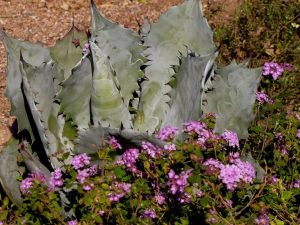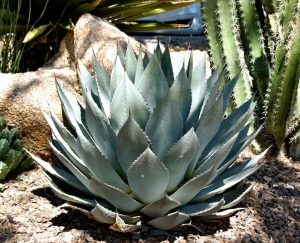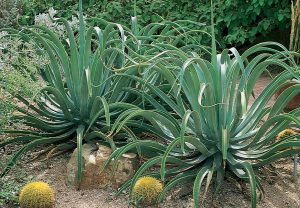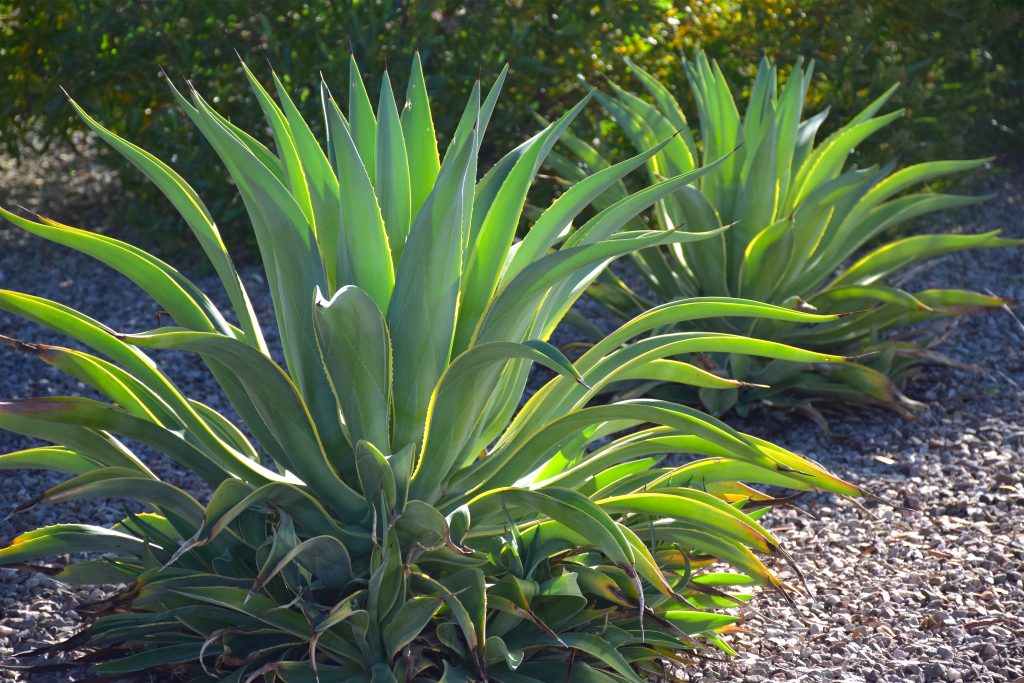Agaves are impressive leaf succulents with a wide range of color, texture and size to their rosettes. There are approximately 200 species found throughout the southwest, Mexico, and Central America. The bold rosettes are dramatic accents for the garden that contrast well with the fine texture of desert trees and shrubs. Agaves are some of the most useful desert plants, tolerant of heat, cold, drought, and poor soil. Agaves, also called century plants, take from five to fifty years to finally flower, often with a spectacular flowering stalk. After blooming, the plant slowly dies. However, they often produce offsets, seeds or bulbils (plantlets).
Because of their sharp leaves and the large size of some agaves, avoid placing close to walkways, windows, or patios. Medium to small agaves work well in containers or combined with groundcovers and wildflowers for the garden. They are best suited for fall and late winter planting. Agaves may need to be treated occasionally for agave snout weevil.

Agave colorata, Mescal Ceniza
This unusual agave has exceptional, heavily “toothed” marbled gray-green leaves which bear bud printing (the impression of adjacent leaves). Agave colorata grows to approximately 2 feet by 2 feet. This Sonoran native offers good contrast to green groundcovers, mesquite and ironwood. Its light yellow flowers are borne on a short stalk.

Agave parryi, Parry’s Agave
One of the most striking and hardy agaves, Parry’s agave grows to about two feet in diameter with compact blue-green rosettes, and bears a spectacular tree-like flowering stalk. This plant can be found throughout the Southwest and Mexico. Excellent for mass planting, Agave parryi works well with wildflowers and also in containers for the patio.

Agave vilmoriniana, Octopus Agave
This agave from northwestern Mexico grows on cliff faces with graceful, twisting, light green unarmed leaves that are approximately 4 feet long. It works well in the ground or a container. Octopus agave bears a striking, brilliant yellow, 20 foot flowering spike followed by numerous bulbils which can be collected and rooted.
Learn more information and find more details about this plant and see additional photos at the Arizona Municipal Water Users Association Landscape Plants for the Arizona Desert plant database.
*Top Photo: Agave desmettiana ‘Marginata’ or Smooth Agave is a little friendlier in public areas. Photo: Donna DiFrancesco
This feature is based on a concept and text originally developed jointly by the Arizona Nursery Association and the Arizona Municipal Water Users Association (AMWUA) with partial funding from the Arizona Department of Water Resources.


